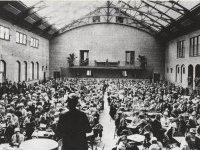


Built in 1914, Hawthorn Hill was the home of Orville, Milton, and Katharine Wright. Wilbur and Orville Wright intended for it to be their joint home, but Wilbur died in 1912, before the home's 1914 completion. The brothers hired the prominent Dayton architectural firm of Schenck and Williams to realize their plans.
Originally spanning seventeen acres, one thought is that the Wrights named the home after the hawthorn trees found on the property. Another belief is that they named the home for 7 Hawthorn St. in Dayton, their previous home.
Orville Wright designed many of the mechanical features of the house, such as the shower, the water storage tank used to collect and recycle rainwater, and the central vacuum system. The family lived in the home for thirty-four years and entertained national dignitaries and inventors such as Henry Ford, Alexander Graham Bell and Thomas Edison.
The NCR Corporation purchased Hawthorn Hill after Orville Wright's death in 1948 for $75,000. The company used the property as a guesthouse for corporate visitors. On rare occasion NCR would open the home to the general public.
While NCR extensively redecorated the home, Orville's study remains intact. Photographs of the interior at the time of Orville's death are available through the NCR Collection managed by Dayton History. Home furnishings are stored at the Kettering-Moraine Museum. Some home furnishings have returned to Hawthorn Hill.
On August 18, 2006, NCR donated the historic home to the Wright Family Foundation, an affiliate of The Dayton Foundation, in honor of Orville's 135th birthday and National Aviation Day. The home was designated a National Historic Landmark in 1991 by the National Park Service. Currently (2020), the home is managed by Dayton History and listed on the National Register of Historic Places.
This property is located at the corner of Park and Harman Avenues.

Located just west and slightly north of the intersection of West Dixon and Runnymede, a contemporary home stands on the former site of the Runnymede Playhouse, a building that played a unique part in the City of Oakwood's history. Originally part of the Talbott family estate, Runnymede Playhouse was first a social and entertainment center for the Oakwood community. During World War II, the playhouse was used as a facility for research and refinement of polonium bomb triggers.
Harry Talbott was one of the founders of the Dayton Metal Products Company and the Dayton-Wright Airplane Company. A civil engineer, he was one of Oakwood's first residents and became Oakwood's first mayor. Following his death in 1921, his wife, Katherine Houk Talbott, remained prominent in Dayton's social and cultural life. In 1927, she had the Runnymede Playhouse, a glass-topped structure large enough for 1200 women to play bridge, built on the family’s property in west Oakwood. The Runnymede Playhouse was used for community functions such as graduations, dances, and meetings as well as serving as an entertainment venue for the Talbott family. The complex included indoor tennis and squash courts as well as a ballroom and stage.
In the 1940s, Dr. Charles Allen Thomas, an engineer who had married into the Talbott family, assisted the Monsanto Chemical Company in procuring a lease on Runnymede Playhouse. He promised his mother-in-law, Katherine Talbott, that he'd return the playhouse in the same condition. The playhouse was used to conduct research into polonium, an element used in the production of atomic weapons. Polonium forms part of atomic bomb triggers and is still a part of weapon construction. The Runnymede Playhouse (also known as Unit IV), was one of five facilities around Dayton involved in nuclear bomb research. Nearly 90 people worked at Unit IV. Oral histories state that big trucks rolled in and out, and floodlights and heavy duty power lines were strung around the property. In 1949, operations moved to Miamisburg, and the following year the Runnymede Playhouse was demolished. The structure and ground were transported to Tennessee for safe burial. In 1998, The Ohio EPA working with the Ohio Department of Health determined that no immediate health risks are posed by the site.